I have a few bits of biological blarney to pass along before I focus later today on packing for Ghost Ranch. I woke up earlier than my intention this morning, so I’ll use my pre-dawn coffee to power an hour for tossing out a few images from recent outings.
I did go last week on my second Audubon First Friday bird walks, but did not come back with any songbird pix this time. The day was overcast and my Lumix FZ200 camera does not gather sufficient light for long shots of tiny birds in shadows. And so I botanized while others strained to find the Northern Waterthrush hidden in the bush.
These mostly flowering plant shots go in my Nature Notebook for Missouri that I started one year ago today: September 10, 2024—the day the moving van unloaded our lives into a tiny apartment in Columbia, Missouri—a memorable anniversary if not necessarily a very happy one. But now a year has passed, and my life is sorting itself out a bit.
There are not many roadways around and even in the town of Columbia where there is not easy access nearby to a park or a trail system along a creek below limestone bluffs. The “gravel” along these stream banks is always interesting (see the final image)—mostly eroded from ancient seabeds or perhaps some carried into the area by the leading edge of a glacial front that pushed south and left us the Missouri River along is farthest southern advance.
The Friday birding forays I have joined have both been to the 3M Wetlands trail on the west side of town. One could follow Hinkson Creek across most of the width of town, crossing under busy roads to access the next ample parking for dog-walkers, bird watchers and Bo-Zos like me.
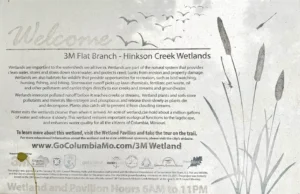
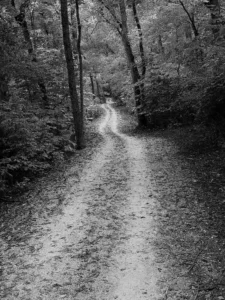
I am now recognizing many local natives that were new to me a year ago, like the Burr Oak below, this time of year sporting acorns with a shaggy-mane cap that covers half the nut. There is a massive specimen of this oak species not far away that every native has visited. Now, at one year, I am an incipient native and must visit soon.
McBaine Burr Oak (Lewis and Clark National Historic Trail)
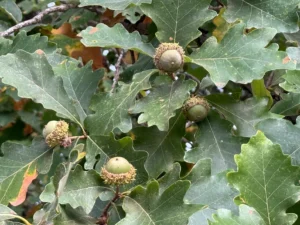
There are some Southwest Virginia invasives that thankfully are either missing entirely or not currently doing much invading here yet. But I was disappointed to see Japanese Knotweed present along the wet edges in full sun and waiting its turn.
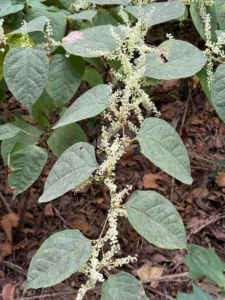
Flowering spurge (family Euphorbiaceae) is a delicate unassuming little thing that would, were its quarter-inch blooms an inch across, find its place in sunroom flower arrangements this time of year along with goldenrod, Giant Lobelia and iron week. (I was disappointed to learn that I should not expect to see a seasonal favorite, Joe Pye Weed, in local meadows in central Missouri.)

Prickly locust is a tree you don’t want to lean up against. You can see here a few of the stout thorns that grace its trunk and branches. But is fruits are something fancy. I picked up a few on my morning jog last week and have them hanging from my window blinds.
They lose their markings and go dark but still retain a nice sculpted shape for a botanical accent in an otherwise sterile apartment that is, I tell visitors, furnished and decorated in the “Sanford and Son” style of unkempt eclectic yard sale relicts and general flotsam randomly displayed without apology.
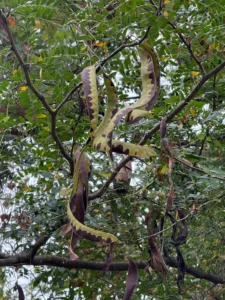
This delicate climbing vine (Japanese hops) seems innocuous enough, and once I had paid sufficient attention to it, I saw it everywhere along the wetlands trail. Now I am disappointed to have learned that this non-native has been gaining a foothold (or roothold I guess) since the late 1800s when it was imported for use in Asian medicine and as an ornamental. Meh.
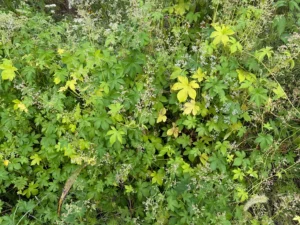
And for some reason I saw fit to render in black and white these Orange Coneflowers (Rudbeckia fulgida) that grow in profusion along the path.
Altogether, my recent bird-walk that became a plant-walk was a success and I was glad I went, but for different reasons that the rest of the large group of feather-fanciers.
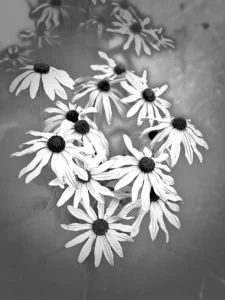
Lastly: This fossil has me stumped. I have reached out to more knowledgeable folks for help, and might just carry it to the Australian geologist from MU who spoke to a gathered group here on the Elder Farm a few months back.
One similar image “out there” suggests the tapered wedges might be impressions of the teeth of a mosasaur—an ancient marine reptile from the late Cretaceous. Nope. The age of the rock matrix makes it way older than Cretaceous critters. So the mystery persists.
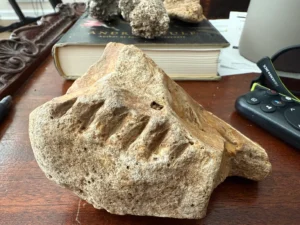
I will see you again later in the week of September 22 upon my return from Ghost Ranch, when my brain will be full and I will be thankful for this space to offload words and images about the experience. Be well!
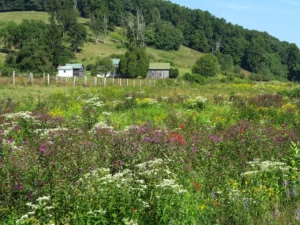
 – Fred First is an author, naturalist, photographer watching Nature under siege since the first Earth Day. Cautiously hopeful. Writing to think it through. Thanks for joining me. Subscribe to My Substack HERE.
– Fred First is an author, naturalist, photographer watching Nature under siege since the first Earth Day. Cautiously hopeful. Writing to think it through. Thanks for joining me. Subscribe to My Substack HERE.

